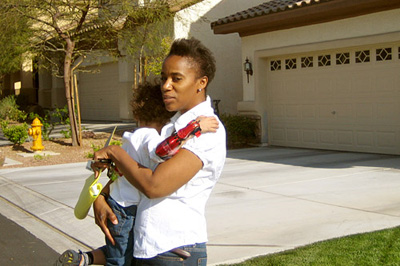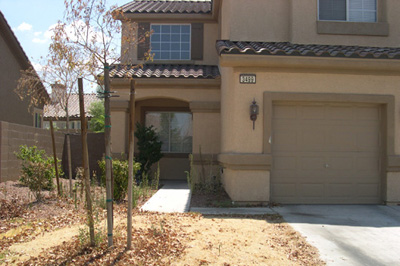The Ones Who Thought They Were Protected
part 1, 2

When Karen Lewis and her son Cooper first moved to a gated community in Las Vegas, she liked the well-tended yards, and being "associated with a bit of exclusivity."
Photo by Krissy Clark
Karen Lewis moved to Las Vegas with her husband and young son in 2005. They were "equity refugees" in search of a place where the money they made off the real estate boom in California would go farther. They sold their modest home in San Diego for $220,000 more than they paid, and headed to Las Vegas to upgrade their American dream. They bought a five-bedroom, three-and-a-half bath Hacienda-style house with high ceilings, granite-countertops, and a dramatic view of the mountains. It cost them $435,000. They put down $200,000, and were left with a mortgage they could easily manage with her income as a business consultant and his as chemical engineer.
Their Las Vegas house - "my dream house," Lewis called it - is in a gated community called San Niccolo. When they moved here, San Niccolo was a stately new development, bordering a golf course, across the street from multi-million dollar mansions. Lewis says when she told people where she lived, they would raise their eyebrows and say, "Oh." It made her feel good. Her husband is a runner, and they developed friendships with the neighbors he met during after-work jogs through the area's well-lit trails. Lewis says as clichéd as it might sound, she moved to San Niccolo for a certain version of success in suburbia, one that involved living next to other young professional families who had nice cars, well-tended yards, maybe a golden retriever or two.
But just three years later, Karen Lewis' image of success in suburbia was starting to crack. She and her husband had decided to divorce, and San Niccolo was no longer the stately suburban community they bought into. Houses were empty. Lawns were dead. The gate that circled San Niccolo had been rammed, dented and broken several times by tow trucks coming to repossess cars.
San Niccolo had become a victim of the sub-prime mortgage crisis. Twenty-four of the 214 homes were in foreclosure. Some people had bought more than they could afford using exotic mortgages, and house prices were sinking. Lewis' house was now worth about $115,000 less than she and her husband had paid for it. That was actually good news for her; it meant she didn't have to pay as much to buy out her husband's half of the house in the divorce. He was now living in an apartment, while she and her 4-year-old son Cooper stayed in San Niccolo. But she was starting to feel uneasy here, living next to so many vacant houses.

In Foreclosure City, a dead lawn can be a tell-tale sign of a bank-owned house.
Photo by Krissy Clark
"There's an empty!" her 4-year-old son Cooper shouts on a walk through the neighborhood. He points proudly to a beige house with a pile of aging phone books on the stoop.
"That's probably a foreclosure," his mom agrees, fingering a gash in the stucco. "That damage looks willful." Lewis explains that when homeowners are forced to leave, they sometimes take their anger out on the house before they go. "And I don't blame them," she says. They inspire a mixture of sympathy and frustration. Mostly, Lewis is glad she's not one of them. Even so, foreclosure is a word little Cooper can define. "Not living in a house," he says. Lewis looks at him, surprised. "I guess when the mommies talk, they do listen."
Lewis has grown close to other mothers in the neighborhood, and she's sad seeing some of them leave. New neighbors are moving in. Renters mostly. They're filling up the empty houses that speculators had planned to flip but now can't. The tenants are 20-somethings who throw loud parties, or multiple families living together in a single-family home. Petty crime has become a bit of a problem; a wave of purse-snatchings, break-ins, tire-slashings. The police suspect drug and gang activity in the neighborhood, and some residents have bought guns and guard dogs for protection.
But Lewis doesn't blame all the problems in San Niccolo on her new neighbors. She's getting used to the idea of living in a working-class neighborhood, filled with taxi drivers and bartenders, rather than the young professionals she had imagined. She points down the street to where a new family just moved in. They're running a car detailing business out of the garage. "So they actually have their customers come to their house. And in the middle of a Saturday afternoon they clean the cars, and they have music playing, and they sit out in their lawn chairs, drinking beer and talking to their friends. I didn't expect to have that kind of traffic in my street," she says. Then she pauses. "But they're awesome neighbors. They're the ones that slow down whenever they see a kid in the street." They've come to San Niccolo to live their dream, just like she did.
Continue to part 2

